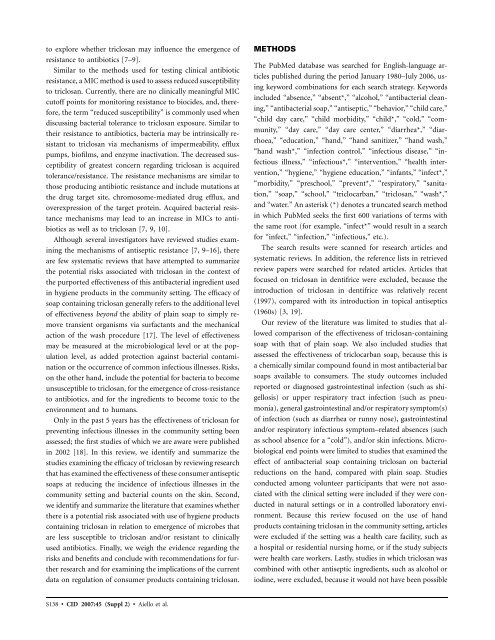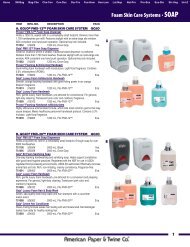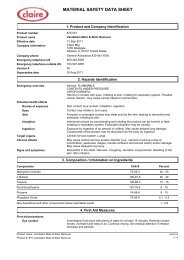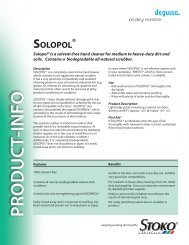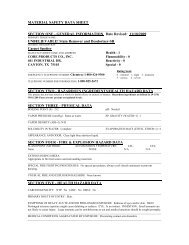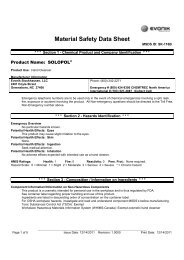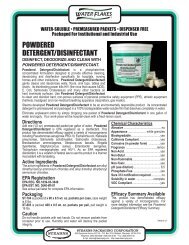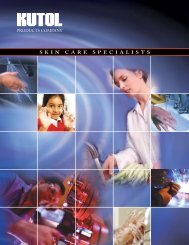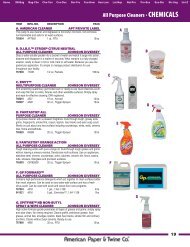Triclosan - Myers Supply & Chemical
Triclosan - Myers Supply & Chemical
Triclosan - Myers Supply & Chemical
Create successful ePaper yourself
Turn your PDF publications into a flip-book with our unique Google optimized e-Paper software.
to explore whether triclosan may influence the emergence of<br />
resistance to antibiotics [7–9].<br />
Similar to the methods used for testing clinical antibiotic<br />
resistance, a MIC method is used to assess reduced susceptibility<br />
to triclosan. Currently, there are no clinically meaningful MIC<br />
cutoff points for monitoring resistance to biocides, and, therefore,<br />
the term “reduced susceptibility” is commonly used when<br />
discussing bacterial tolerance to triclosan exposure. Similar to<br />
their resistance to antibiotics, bacteria may be intrinsically resistant<br />
to triclosan via mechanisms of impermeability, efflux<br />
pumps, biofilms, and enzyme inactivation. The decreased susceptibility<br />
of greatest concern regarding triclosan is acquired<br />
tolerance/resistance. The resistance mechanisms are similar to<br />
those producing antibiotic resistance and include mutations at<br />
the drug target site, chromosome-mediated drug efflux, and<br />
overexpression of the target protein. Acquired bacterial resistance<br />
mechanisms may lead to an increase in MICs to antibiotics<br />
as well as to triclosan [7, 9, 10].<br />
Although several investigators have reviewed studies examining<br />
the mechanisms of antiseptic resistance [7, 9–16], there<br />
are few systematic reviews that have attempted to summarize<br />
the potential risks associated with triclosan in the context of<br />
the purported effectiveness of this antibacterial ingredient used<br />
in hygiene products in the community setting. The efficacy of<br />
soap containing triclosan generally refers to the additional level<br />
of effectiveness beyond the ability of plain soap to simply remove<br />
transient organisms via surfactants and the mechanical<br />
action of the wash procedure [17]. The level of effectiveness<br />
may be measured at the microbiological level or at the population<br />
level, as added protection against bacterial contamination<br />
or the occurrence of common infectious illnesses. Risks,<br />
on the other hand, include the potential for bacteria to become<br />
unsusceptible to triclosan, for the emergence of cross-resistance<br />
to antibiotics, and for the ingredients to become toxic to the<br />
environment and to humans.<br />
Only in the past 5 years has the effectiveness of triclosan for<br />
preventing infectious illnesses in the community setting been<br />
assessed; the first studies of which we are aware were published<br />
in 2002 [18]. In this review, we identify and summarize the<br />
studies examining the efficacy of triclosan by reviewing research<br />
that has examined the effectiveness of these consumer antiseptic<br />
soaps at reducing the incidence of infectious illnesses in the<br />
community setting and bacterial counts on the skin. Second,<br />
we identify and summarize the literature that examines whether<br />
there is a potential risk associated with use of hygiene products<br />
containing triclosan in relation to emergence of microbes that<br />
are less susceptible to triclosan and/or resistant to clinically<br />
used antibiotics. Finally, we weigh the evidence regarding the<br />
risks and benefits and conclude with recommendations for further<br />
research and for examining the implications of the current<br />
data on regulation of consumer products containing triclosan.<br />
S138 • CID 2007:45 (Suppl 2) • Aiello et al.<br />
METHODS<br />
The PubMed database was searched for English-language articles<br />
published during the period January 1980–July 2006, using<br />
keyword combinations for each search strategy. Keywords<br />
included “absence,” “absent*,” “alcohol,” “antibacterial cleaning,”<br />
“antibacterial soap,” “antiseptic,” “behavior,” “child care,”<br />
“child day care,” “child morbidity,” “child*,” “cold,” “community,”<br />
“day care,” “day care center,” “diarrhea*,” “diarrhoea,”<br />
“education,” “hand,” “hand sanitizer,” “hand wash,”<br />
“hand wash*,” “infection control,” “infectious disease,” “infectious<br />
illness,” “infectious*,” “intervention,” “health intervention,”<br />
“hygiene,” “hygiene education,” “infants,” “infect*,”<br />
“morbidity,” “preschool,” “prevent*,” “respiratory,” “sanitation,”<br />
“soap,” “school,” “triclocarban,” “triclosan,” “wash*,”<br />
and “water.” An asterisk (*) denotes a truncated search method<br />
in which PubMed seeks the first 600 variations of terms with<br />
the same root (for example, “infect*” would result in a search<br />
for “infect,” “infection,” “infectious,” etc.).<br />
The search results were scanned for research articles and<br />
systematic reviews. In addition, the reference lists in retrieved<br />
review papers were searched for related articles. Articles that<br />
focused on triclosan in dentifrice were excluded, because the<br />
introduction of triclosan in dentifrice was relatively recent<br />
(1997), compared with its introduction in topical antiseptics<br />
(1960s) [3, 19].<br />
Our review of the literature was limited to studies that allowed<br />
comparison of the effectiveness of triclosan-containing<br />
soap with that of plain soap. We also included studies that<br />
assessed the effectiveness of triclocarban soap, because this is<br />
a chemically similar compound found in most antibacterial bar<br />
soaps available to consumers. The study outcomes included<br />
reported or diagnosed gastrointestinal infection (such as shigellosis)<br />
or upper respiratory tract infection (such as pneumonia),<br />
general gastrointestinal and/or respiratory symptom(s)<br />
of infection (such as diarrhea or runny nose), gastrointestinal<br />
and/or respiratory infectious symptom–related absences (such<br />
as school absence for a “cold”), and/or skin infections. Microbiological<br />
end points were limited to studies that examined the<br />
effect of antibacterial soap containing triclosan on bacterial<br />
reductions on the hand, compared with plain soap. Studies<br />
conducted among volunteer participants that were not associated<br />
with the clinical setting were included if they were conducted<br />
in natural settings or in a controlled laboratory environment.<br />
Because this review focused on the use of hand<br />
products containing triclosan in the community setting, articles<br />
were excluded if the setting was a health care facility, such as<br />
a hospital or residential nursing home, or if the study subjects<br />
were health care workers. Lastly, studies in which triclosan was<br />
combined with other antiseptic ingredients, such as alcohol or<br />
iodine, were excluded, because it would not have been possible


